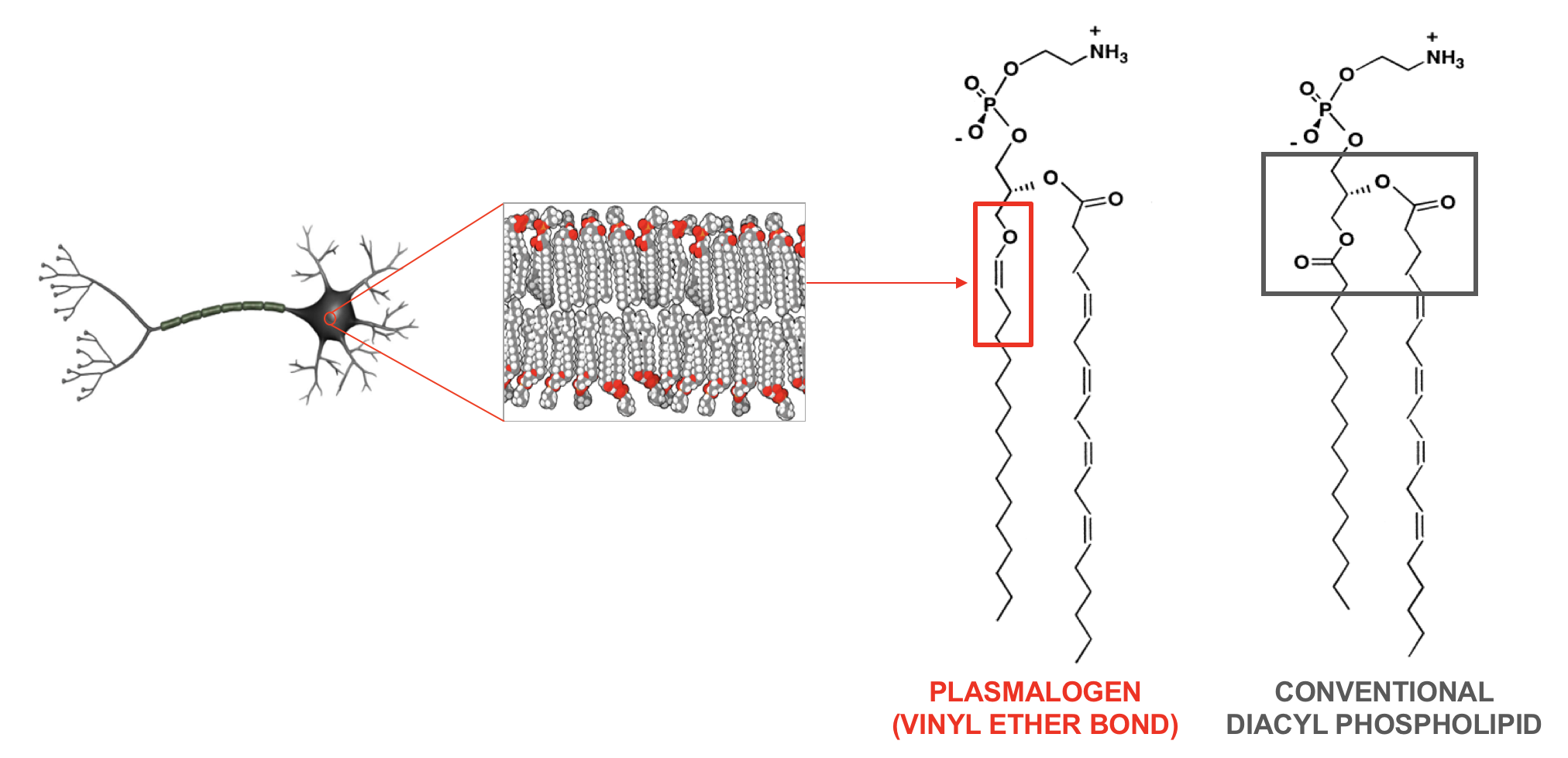
Plasmalogens
One of the most critical lipids in the body. . .
PLASMALOGEN PHOSPHOLIPIDS
Plasmalogens are a unique family of cell membrane glycerophospholipids that contain a vinyl-ether bond. A glycerophospholipid is built by the body through the attachment of fatty acids to a three-carbon glycerol backbone. Examples of fatty acids include those from the diet such as the 18-carbon linoleic and linolenic acids, DHA (a 22-carbon fatty acid), and many others. Fatty acids are joined to two carbons of the glycerol backbone (often referred to as the sn-1 and sn-2 positions) through specific chemical bonds. When the chemical bond connecting the fatty acid to the sn-1 position is a vinyl-ether bond, the lipid is referred to as a plasmalogen.
A neuronal cell is shown on the left. The membrane surface of the cell is composed of the lipid membrane bilayer, which contains two rows of lipid molecules packed closely together. This layer essentially acts as a barrier, controlling what enters and leaves the cell. It also serves as the location for which many cell surface proteins, such as receptors, are anchored. Such cell surface proteins are involved in cell-cell communication, activation of signalling pathways involved in various cellular functions, and more.
There are multiple types of phospholipids that make up the cell membrane. Plasmalogens represent one class of lipids, as shown above, that contain the vinyl-ether bond (red box). In contrast, a conventional phospholipid contains two acyl bonds, as shown in the black box. In some cell types, such as neurons, over 50% of the cell membrane can be comprised of plasmalogens.
Plasmalogens are synthesized in a subcellular organelle called the peroxisome, which contains enzymes for creating a critical ether bond that is then reduced to become an active plasmalogen species. The therapeutic strategy developed and patented by MLD is to synthetically provide the body with metabolic precursor products that contain the chemical bonds that the peroxisomal enzymes normally produce. MLD has a broad patent portfolio of numerous synthetic plasmalogen compounds containing a vast number of possible chemical structures.
Peroxisomes are tiny organelles in a cell that carry out specific metabolic functions, including the first steps of plasmalogen biosynthesis. The therapeutic approach at MLD is to bypass plasmalogen biosynthetic enzymes with plasmalogen precursors. PPI-1011 is an ether-containing precursor that a human adult can metabolically convert into a vinyl-ether plasmalogen that is then used by the body to augment the entire endogenous plasmalogen pool, while PPI-1040, designed exclusively for Rhizomelic Chondrodysplasia Punctata (RCDP) contains a fully intact and stabilized vinyl-ether bond that requires NO metabolic conversion by the body into an endogenous plasmalogen species.
KEY PLASMALOGEN FUNCTIONS
One of the main functions of plasmalogens is their effect on the physical structure of the cell membrane. Cell membranes containing plasmalogens have a different structure, being more highly-ordered and rigid. This is because the fatty acid side-chains are located more closely together due to the vinyl-ether bond, resulting in a more tightly-packed structure. One cell function, in particular, that is highly sensitive to the amount of plasmalogen in the membrane, is a process called vesicular fusion.
Simple video illustrating the process of vesicular fusion.
The lower the membrane plasmalogen level, the less likely it is that the vesicle will fuse to the cell membrane. One critical physiological function that is completely dependent on vesicular fusion is neurotransmission. Neurotransmission is the process whereby electrical signals, called action potentials, are relayed from the end of one neuron to the beginning of adjacent neurons. In simple terms, vesicles inside of neurons hold chemicals called neurotransmitters. When an action potential travels through a neuron and reaches the end-terminal, called the pre-synaptic terminal, it signals the vesicles containing neurotransmitters to fuse to the membrane, and in doing so, release their contents into the extracellular space (referred to as the synaptic cleft) between the ends of the neurons. The neurotransmitters then move through the presynaptic cleft and bind to receptors on the next neuron (called the post-synaptic terminal), resulting in the creation of a new action potential that propagates along the length of the neuron, and the process repeats. This process is also much easier to grasp through visualization as shown in the Chemical Synapse Animation.
Video illustrating the process of synaptic transmission by vesicular fusion.
Obviously, many physiological processes, both in the central and peripheral nervous systems, including muscle contractions, pain and discomfort, awareness, cognition, vision, and many others, rely on vesicular fusion-mediated neurotransmitter release. If membranes don't contain healthy amounts of plasmalogens, some of these functions will undoubtedly be compromised.
There are several other roles that plasmalogens play in the body. These include protection against oxidative stress, regulation of cholesterol levels, and formation of optimal cell membrane microdomains, which is another membrane structural phenomenon that is required for the function of many membrane-anchored proteins.
Therefore, if the levels of plasmalogens decline within the body, a number of these physiological and biochemical functions will be compromised.

